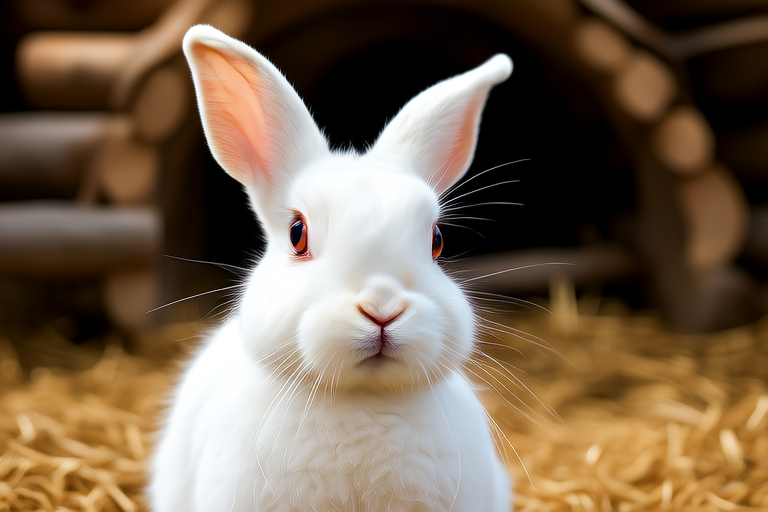From Farm to Furry Friend: Discovering the Unique Charm of Hotot Rabbits
Welcome to the world of Hotot rabbits! These charming creatures have captured the hearts of many with their unique appearance and gentle nature. In this article, we will explore the origins and history of Hotot rabbits, their distinctive physical characteristics, temperament and care requirements, popular uses from farming to companionship, common health issues, breeding tips, and personal stories or anecdotes that highlight their charm. Whether you’re a seasoned rabbit enthusiast or a newcomer to the world of pet rabbits, there’s something here for everyone.
The Origins and History of Hotot Rabbits
The Hotot rabbit breed originated in France during the early 20th century. It was developed by Eugenie Bernhard, a French breeder who aimed to create a rabbit with a striking white body and black eyes. The name ‘Hotot’ comes from the village where Bernhard lived, named Hotot-en-Auge. She worked tirelessly to perfect the breed, combining the best traits from other rabbit breeds like the Checkered Giant, Beveren, and Blanc de Hotot. Her efforts paid off, and the Hotot rabbit quickly gained popularity among rabbit fanciers.
Distinctive Physical Characteristics
One of the most striking features of the Hotot rabbit is its appearance. They have a pure white coat, which contrasts beautifully with their black-rimmed eyes. This unique eye color gives them an almost doll-like look, making them incredibly photogenic. Hotots typically weigh between 4 to 6 pounds, making them medium-sized rabbits. Their short, dense fur is easy to maintain but requires regular grooming to prevent matting.
Temperament and Care Requirements
Hotot rabbits are known for their calm and docile temperament, making them ideal pets for families with children. They are generally good-natured and enjoy human interaction. However, they can be somewhat shy at first, so it’s important to give them time to adjust to new environments and people. Providing a safe, quiet space for your Hotot to relax is essential for their well-being.
Caring for a Hotot rabbit involves several key aspects. Firstly, ensure they have a spacious hutch or cage that allows plenty of room for movement. A wire-bottomed cage is recommended as it helps keep their feet dry and prevents the buildup of urine and feces. Secondly, provide a soft bedding material such as straw or shredded paper. Avoid cedar or pine shavings as they can irritate your rabbit’s respiratory system. Lastly, offer fresh water daily and a balanced diet consisting of hay, pellets, and occasional treats like fresh vegetables.
Popular Uses: From Farming to Companionship
Originally bred for meat production, Hotot rabbits have since become popular as companion animals due to their appealing looks and gentle nature. While some farmers still raise them for their meat, most owners today keep Hotots as pets. Their compact size makes them suitable for apartment living, provided they receive enough exercise and mental stimulation.
In addition to being wonderful companions, Hotot rabbits also excel in showmanship. Their striking appearance and elegant posture make them highly sought after in rabbit shows. If you’re interested in participating in these events, consider joining local clubs or associations dedicated to rabbit breeding and exhibition.
Common Health Issues
Like all domesticated animals, Hotot rabbits may face certain health challenges. One common issue is dental problems, particularly malocclusion (misalignment of teeth). Regular check-ups with a veterinarian specializing in exotic pets can help catch potential issues early. Another concern is digestive disorders caused by improper diet or lack of exercise. Always consult your vet if you notice any changes in your rabbit’s behavior or appetite.
Breeding Tips
If you’re considering breeding Hotot rabbits, there are several factors to keep in mind. First, ensure both parents come from reputable lines and are free from genetic defects. Second, provide adequate space for nesting boxes and litter areas. Third, monitor the mother closely during pregnancy and nursing to ensure she has everything she needs. Finally, socialize young kits early to promote healthy development and reduce aggression later in life.
Personal Stories and Anecdotes
Let me share a few personal stories about Hotot rabbits that highlight their charm:
One owner, Sarah, adopted a Hotot named Snowball after her previous rabbit passed away. At first, Snowball was quite timid around visitors, but with patience and gentle handling, he soon became comfortable in his new home. Now, he enjoys sitting on Sarah’s lap while she reads or watches TV. His playful demeanor and affectionate nature bring joy to her everyday life.
Another story comes from John, who runs a small farm where he raises various livestock including Hotot rabbits. He recounts how one particular Hotot, named Blackie, saved his day when he got stuck inside a pen during feeding time. Without hesitation, Blackie alerted John by thumping his hind legs repeatedly until help arrived. This incident not only demonstrated Blackie’s intelligence but also strengthened John’s bond with his furry friends.
Conclusion
From their captivating origins to their endearing personalities, Hotot rabbits offer much more than just companionship; they bring warmth and happiness into our lives. By understanding their needs and providing proper care, we can ensure these delightful creatures remain cherished members of our families for years to come.
